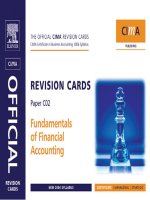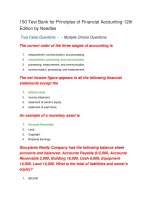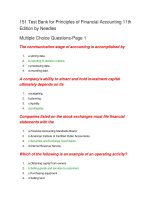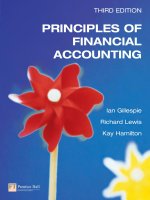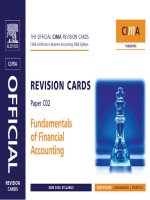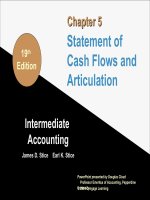Principles of financial accounting 12e by needles crosson chapter 05
Bạn đang xem bản rút gọn của tài liệu. Xem và tải ngay bản đầy đủ của tài liệu tại đây (402.3 KB, 37 trang )
CHAPTER
5
Foundations of Financial
Reporting and the
Classified Balance Sheet
Principles of
Accounting
12e
Needles
Powers
Crosson
© human/iStockphoto
LEARNING OBJECTIVES
LO1: Describe the objective of financial
reporting, and identify the conceptual
framework underlying accounting information.
LO2: Identify and define the basic
components of financial reporting, and
prepare a classified balance sheet
LO3: Use classified financial statements to
evaluate liquidity and profitability.
©2014 Cengage Learning. All Rights Reserved. May not be scanned, copied or duplicated, or posted to a publicly accessible website, in whole or in part.
SECTION 1: CONCEPTS
(slide 1 of 3)
Re le vanc e : information has a direct bearing on a decision
– Pre dic tive value : information helps capital providers make
decisions about future actions
– Co nfirmative value : information confirms or changes previous
evaluations
– Mate riality: the omission or misstatement of information could
influence the user’s economic decisions taken on the basis of the
financial statements
Faithful re pre s e ntatio n: information is complete, neutral, and
free from material error
– Co mple te ne s s : all information necessary for a reliable decision is
provided
– Ne utrality: information is free from bias intended to achieve a
certain result or bring about a particular behavior
– Fre e fro m mate rial e rro r: information meets a minimum level of
accuracy so it does not distort what is being reported
©2014 Cengage Learning. All Rights Reserved. May not be scanned, copied or duplicated, or posted to a publicly accessible website, in whole or in part.
SECTION 1: CONCEPTS
(slide 2 of 3)
Enhanc ing qualitative c harac te ris tic s
– Co mparability: the quality that enables users to identify
similarities and differences between two sets of financial
data
– Ve rifiability: the quality that different knowledgeable and
independent observers could reach consensus, although
not necessarily complete agreement, that a particular
depiction is a faithful representation
– Time line s s : the quality that enables users to receive
information in time to influence their decisions
– Unde rs tandability: the quality that enables users to
comprehend the meaning of information
– Co s t c o ns traint (c o s t-be ne fit): the benefits to be gained
from providing accounting information should be greater
than the costs of providing it
©2014 Cengage Learning. All Rights Reserved. May not be scanned, copied or duplicated, or posted to a publicly accessible website, in whole or in part.
SECTION 1: CONCEPTS
(slide 3 of 3)
Ac c o unting c o nve ntio ns : constraints used in
preparing financial statements
– Co ns is te nc y: once a company has adopted an accounting
procedure, it must use it from one period to the next unless
a note to the financial statements informs users of a change
– Full dis c lo s ure (trans pare ncy): financial statements must
present all the information relevant to users’ understanding
of the statements
– Co ns e rvatis m: when faced with choosing between two
equally acceptable procedures or estimates, accountants
should choose the one that is least likely to overstate
assets and income
©2014 Cengage Learning. All Rights Reserved. May not be scanned, copied or duplicated, or posted to a publicly accessible website, in whole or in part.
Objective of Financial Reporting
To be useful for decision making, financial reporting
must enable the user to
– Assess cash flow prospects
– Assess management’s stewardship
Financial reporting includes the financial statements
(balance sheet, income statement, statement of
owner’s equity, and statement of cash flows) that are
prepared periodically.
– Management’s underlying assumptions and
methods and estimates used in the financial
statements are also important components of
financial reporting.
©2014 Cengage Learning. All Rights Reserved. May not be scanned, copied or duplicated, or posted to a publicly accessible website, in whole or in part.
Qualitative Characteristics of
Accounting Information
To facilitate interpretation of accounting
information, the FASB has established
standards, or qualitative c harac te ris tic s , by
which to judge the information.
The most fundamental of these
characteristics are:
– Relevance
– Faithful representation
©2014 Cengage Learning. All Rights Reserved. May not be scanned, copied or duplicated, or posted to a publicly accessible website, in whole or in part.
Relevance
(slide 1 of 2)
Re le vanc e means that the information has a
direct bearing on a decision. In other words, if
the information were not available, a different
decision would be made.
– To be relevant, information must have one or both
of the following:
Predictive value—Information has pre dic tive value if it
helps capital providers make decisions about future
actions.
Confirmative value—Information has c o nfirmative value
if it confirms or changes previous evaluations.
©2014 Cengage Learning. All Rights Reserved. May not be scanned, copied or duplicated, or posted to a publicly accessible website, in whole or in part.
Relevance
(slide 2 of 2)
Relevant information is also subject to m ate riality.
– Information is mate rial if its omission or
misstatement could influence the user’s economic
decisions taken on the basis of the specific entity’s
financial statements.
– Mate riality is related to both the nature of an item and its
size or misstatement.
The materiality of an item normally is determined by
relating its dollar value to an element of the financial
statements, such as net income or total assets.
As a rule, when an item is worth 5 percent or more of net
income, accountants treat it as material.
However, many small errors can add up to a material
amount.
©2014 Cengage Learning. All Rights Reserved. May not be scanned, copied or duplicated, or posted to a publicly accessible website, in whole or in part.
Faithful Representation
Faithful re pre s e ntatio n means that the
financial information is complete, neutral, and
free from material errors.
– Co mple te info rmatio n provides all information
necessary for a reliable decision.
– Ne utral info rmatio n is free from bias intended to
achieve a certain result or to bring about a
particular behavior.
– To be fre e fro m mate rial e rro r means
information meets a minimum level of accuracy so
it does not distort what is being reported.
©2014 Cengage Learning. All Rights Reserved. May not be scanned, copied or duplicated, or posted to a publicly accessible website, in whole or in part.
Enhancing Qualitative Characteristics
(slide 1 of 2)
Other characteristics that the FASB has established
for interpreting accounting information include:
– Co mparability—enables users to identify
similarities and differences between two sets of
financial data.
– Ve rifiability—different knowledgeable and
independent observers could reach consensus
that a particular depiction is a faithful
representation.
– Time line s s —enables users to receive information
in time to influence their decisions.
– Unde rs tandability—enables users to
comprehend the meaning of the information.
©2014 Cengage Learning. All Rights Reserved. May not be scanned, copied or duplicated, or posted to a publicly accessible website, in whole or in part.
Enhancing Qualitative Characteristics
(slide 2 of 2)
These enhancing characteristics are subject
to the c o s t c o ns traint (or c o s t-be ne fit),
which holds that the benefits to be gained
from providing accounting information should
be greater than the costs of providing it.
– Minimum levels of relevance and faithful
representation must be reached if accounting
information is to be useful.
– Beyond the minimum levels, it is up to the FASB,
the SEC, and the accountant who provides the
information to judge the costs and benefits in
each case.
©2014 Cengage Learning. All Rights Reserved. May not be scanned, copied or duplicated, or posted to a publicly accessible website, in whole or in part.
Accounting Conventions
(slide 1 of 2)
Ac c o unting c o nve ntio ns , or cons traints , used in
preparing financial statements include:
– Co ns is te nc y—requires that once a company has
adopted an accounting procedure, it must use it
from one period to the next unless a note to the
financial statements informs users of a change.
– Full dis c lo s ure (or trans pare ncy)—requires that
financial statements present all the information
relevant to users’ understanding of the
statements, including:
any explanation needed to keep them from being
misleading.
the disclosure of significant events arising after the
balance sheet date.
©2014 Cengage Learning. All Rights Reserved. May not be scanned, copied or duplicated, or posted to a publicly accessible website, in whole or in part.
Accounting Conventions
(slide 2 of 2)
– Co ns e rvatis m—holds that, when faced
with choosing between two equally
acceptable procedures or estimates, the
accountant should choose the one that is
least likely to overstate assets and income.
Conservatism can be a useful tool, but if
abused, can lead to incorrect or misleading
financial statements.
Accountants should apply the conservatism
convention only when they are uncertain about
which accounting procedure or estimate to
use.
©2014 Cengage Learning. All Rights Reserved. May not be scanned, copied or duplicated, or posted to a publicly accessible website, in whole or in part.
Ethical Financial Reporting
Under the Sarbanes-Oxley Act, chief
executive officers and chief financial officers
of all publicly traded companies must certify
that, to their knowledge, their quarterly and
annual statements are accurate and
complete.
Fraudulent financial reporting can have high
costs for investors, lenders, employees, and
customers—as well as for the people who
condone, authorize, or prepare misleading
reports.
©2014 Cengage Learning. All Rights Reserved. May not be scanned, copied or duplicated, or posted to a publicly accessible website, in whole or in part.
Classified Balance Sheet
General-purpose external financial statements that
are divided into subcategories are called c las s ifie d
financ ial s tate me nts .
The subcategories into which assets, liabilities, and
owner’s equity are broken down are shown below.
©2014 Cengage Learning. All Rights Reserved. May not be scanned, copied or duplicated, or posted to a publicly accessible website, in whole or in part.
Assets
The classified balance sheet typically divides
assets into four categories: current assets;
investments; property, plant, and equipment;
and intangible assets.
These categories are listed in the order of
how easily they can be converted to cash.
Some companies group investments,
intangible assets, and other miscellaneous
assets into a category called o the r as s e ts .
©2014 Cengage Learning. All Rights Reserved. May not be scanned, copied or duplicated, or posted to a publicly accessible website, in whole or in part.
Current Assets
Curre nt as s e ts include cash and other assets that a
company can reasonably expect to convert to cash,
sell, or consume within one year or its normal
operating cycle, whichever is longer.
– A company’s no rmal o pe rating c yc le is the average time it
needs to go from spending to receiving cash.
– Current assets include: cash; short-term investments; notes
and accounts receivable; inventory that a company expects
to convert to cash (by selling it) within the next year or the
normal operating cycle; prepaid expenses; and supplies
bought for use.
©2014 Cengage Learning. All Rights Reserved. May not be scanned, copied or duplicated, or posted to a publicly accessible website, in whole or in part.
Investments
Inve s tme nts include assets, usually long-term,
that are not used in normal business operations
and that management does not plan to convert to
cash within the next year. Examples include:
– Securities held for longterm investment
– Long-term notes
receivable
– Land held for future use
– Plant or equipment not
used in business
– Special funds established
to pay off a debt or buy a
building
– Large permanent
investments made in
another company for the
purpose of controlling that
company
©2014 Cengage Learning. All Rights Reserved. May not be scanned, copied or duplicated, or posted to a publicly accessible website, in whole or in part.
Property, Plant, and Equipment
Pro pe rty, plant, and e quipme nt include tangible
long-term assets used in a business’s day-to-day
operations.
– They are also called ope rating as s e ts , fixe d as s e ts , tangible
as s e ts , long-live d as s e ts , or plant as s e ts .
– Through depreciation, the costs of these assets (except
land) are spread over the periods they benefit.
– To reduce clutter on the balance sheet, property, plant, and
equipment and related accumulated depreciation accounts
are often combined—for example:
Property, plant, and equipment (net)
$116,240
©2014 Cengage Learning. All Rights Reserved. May not be scanned, copied or duplicated, or posted to a publicly accessible website, in whole or in part.
Intangible Assets
Intang ible as s e ts are long-term assets with
no physical substance. Their value stems
from the rights or privileges accruing to their
owners. Examples include:
–
–
–
–
–
Patents
Copyrights
Franchises
Trademarks
Go o dwill—arises in an acquisition of another
company
©2014 Cengage Learning. All Rights Reserved. May not be scanned, copied or duplicated, or posted to a publicly accessible website, in whole or in part.
Liabilities
Liabilities are divided into two categories:
- Curre nt liabilitie s —
obligations that must be
satisfied within one year or
within the company’s
normal operating cycle,
whichever is longer.
Notes payable
Accounts payable
Current portion of longterm debt
Salaries and wages
payable
Customer advances
- Lo ng -te rm liabilitie s —
debts that fall due more
than one year in the
future or beyond the
normal operating cycle.
Mortgages payable
Long-term notes
Bonds payable
Employee pension
obligations
Long-term lease
liabilities
©2014 Cengage Learning. All Rights Reserved. May not be scanned, copied or duplicated, or posted to a publicly accessible website, in whole or in part.
Owner’s Equity
The terms owne r’s e quity, proprie tors hip,
owne r’s capital, and ne t worth are all used to
refer to the owner’s interest, or equity, in a
company.
– The first three terms are preferred to ne t worth
because many assets are recorded at their
original cost rather than at their current value.
The equity section of the balance sheet
differs depending on whether the business is
a sole proprietorship, partnership, or
corporation.
©2014 Cengage Learning. All Rights Reserved. May not be scanned, copied or duplicated, or posted to a publicly accessible website, in whole or in part.
Sole Proprietorship
The owner’s equity section of a sole
proprietorship would be similar to the one
shown for Bonali Company:
©2014 Cengage Learning. All Rights Reserved. May not be scanned, copied or duplicated, or posted to a publicly accessible website, in whole or in part.
Partnership
The equity section of a partnership’s balance
sheet is called partne rs ’ e quity.
It is much like that in a sole proprietorship’s
balance sheet and might appear as follows:
©2014 Cengage Learning. All Rights Reserved. May not be scanned, copied or duplicated, or posted to a publicly accessible website, in whole or in part.
